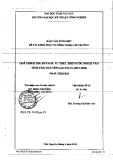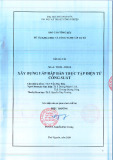
Hindawi Publishing Corporation
EURASIP Journal on Advances in Signal Processing
Volume 2008, Article ID 823695, 17 pages
doi:10.1155/2008/823695
Research Article
Simultaneous Eye Tracking and Blink Detection with
Interactive Particle Filters
Junwen Wu and Mohan M. Trivedi
Computer Vision and Robotics Research Laboratory, University of California, San Diego, La Jolla, CA 92093, USA
Correspondence should be addressed to Junwen Wu, juwu@ucsd.edu
Received 2 May 2007; Revised 1 October 2007; Accepted 28 October 2007
Recommended by Juwei Lu
We present a system that simultaneously tracks eyes and detects eye blinks. Two interactive particle filters are used for this purpose,
one for the closed eyes and the other one for the open eyes. Each particle filter is used to track the eye locations as well as the scales
of the eye subjects. The set of particles that gives higher confidence is defined as the primary set and the other one is defined
as the secondary set. The eye location is estimated by the primary particle filter, and whether the eye status is open or closed
is also decided by the label of the primary particle filter. When a new frame comes, the secondary particle filter is reinitialized
according to the estimates from the primary particle filter. We use autoregression models for describing the state transition and a
classification-based model for measuring the observation. Tensor subspace analysis is used for feature extraction which is followed
by a logistic regression model to give the posterior estimation. The performance is carefully evaluated from two aspects: the
blink detection rate and the tracking accuracy. The blink detection rate is evaluated using videos from varying scenarios, and
the tracking accuracy is given by comparing with the benchmark data obtained using the Vicon motion capturing system. The
setup for obtaining benchmark data for tracking accuracy evaluation is presented and experimental results are shown. Extensive
experimental evaluations validate the capability of the algorithm.
Copyright © 2008 J. Wu and M. M. Trivedi. This is an open access article distributed under the Creative Commons Attribution
License, which permits unrestricted use, distribution, and reproduction in any medium, provided the original work is properly
cited.
1. INTRODUCTION
Eye blink detection plays an important role in human-
computer interface (HCI) systems. It can also be used in
driver’s assistance systems. Studies show that eye blink du-
rationhasacloserelationtoasubject’sdrowsiness[
1]. The
openness of eyes, as well as the frequency of eye blinks, shows
the level of the person’s consciousness, which has potential
applications in monitoring driver’s vigourous level for addi-
tional safety control [2]. Also, eye blinks can be used as a
method of communication for people with severe disabili-
ties, in which blink patterns can be interpreted as semiotic
messages [3–5]. This provides an alternate input modality to
control a computer: communication by “blink pattern.” The
duration of eye closure determines whether the blink is vol-
untary or involuntary. Blink patterns are used by interpreting
voluntary long blinks according to the predefined semiotics
dictionary, while ignoring involuntary short blinks.
Eye blink detection has attracted considerable research
interest from the computer vision community. In literature,
most existing techniques use two separate steps for eye track-
ing and blink detection [2,3,5–8]. For eye blink detection
systems, there are three types of dynamic information in-
volved: the global motion of eyes (which can be used to infer
the head motion), the local motion of eye pupils, and the
eye openness/closure. Accordingly, an effective eye tracking
algorithm for blink detection purposes needs to satisfy the
following constraints:
(i) track the global motion of eyes, which is confined by
the head motion;
(ii) maintain invariance to local motion of eye pupils;
(iii) classify the closed-eye frames from the open-eye
frames.
Once the eyes’ locations are estimated by the tracking al-
gorithm, the differences in image appearance between the
open eyes and the closed eyes can be used to find the frames
in which the subjects’ eyes are closed, such that eye blink-
ing can be determined. In [2], template matching is used to
track the eyes and color features are used to determine the






























